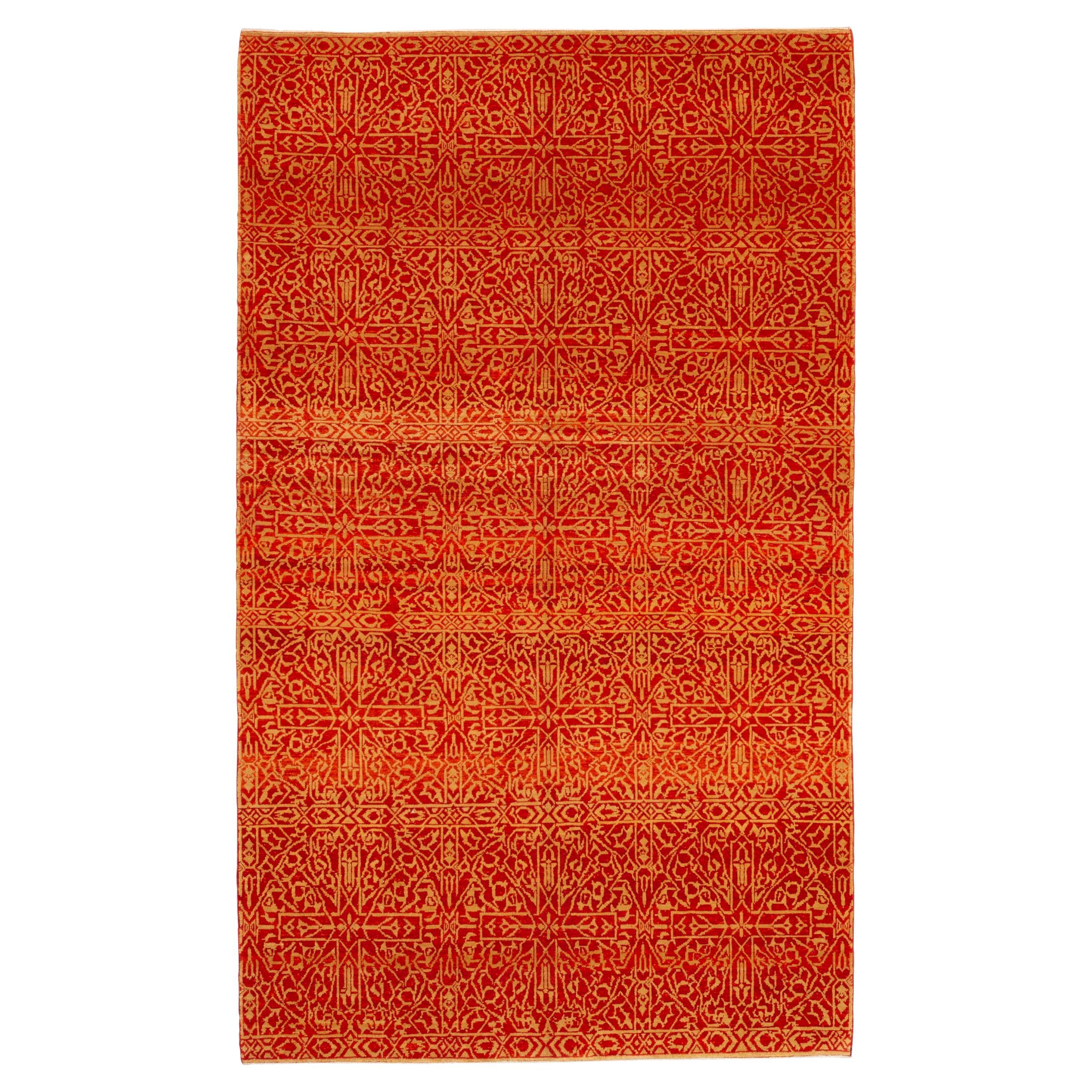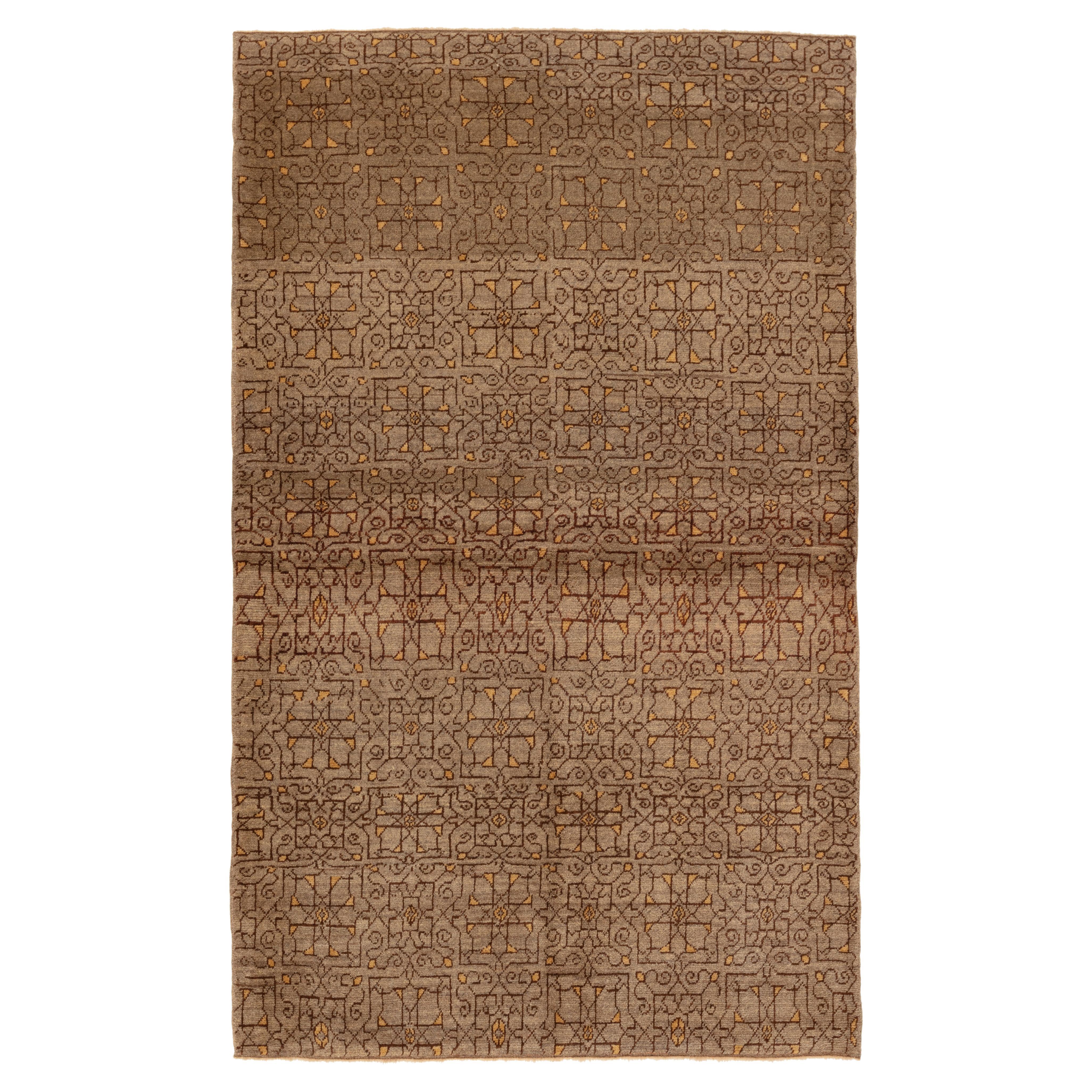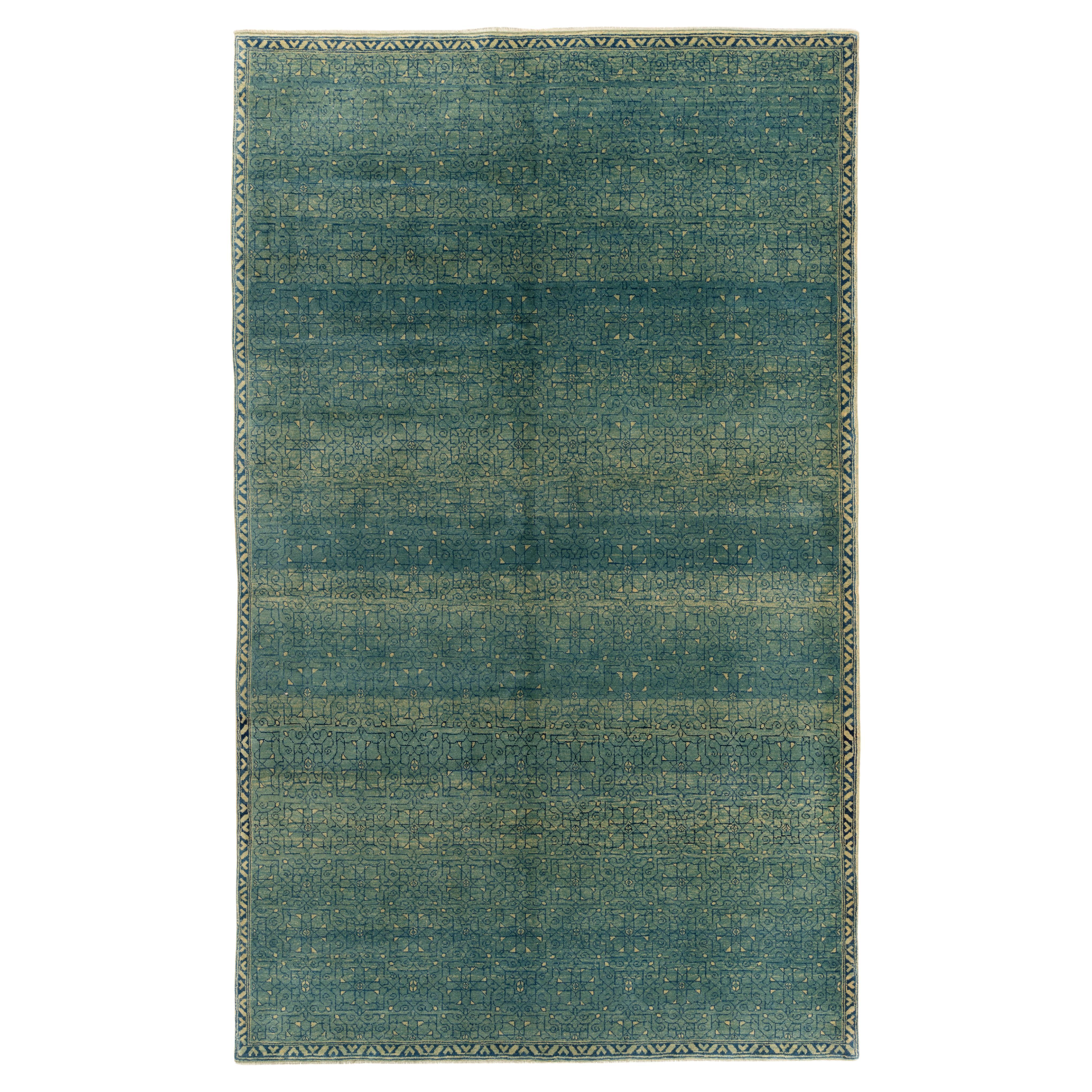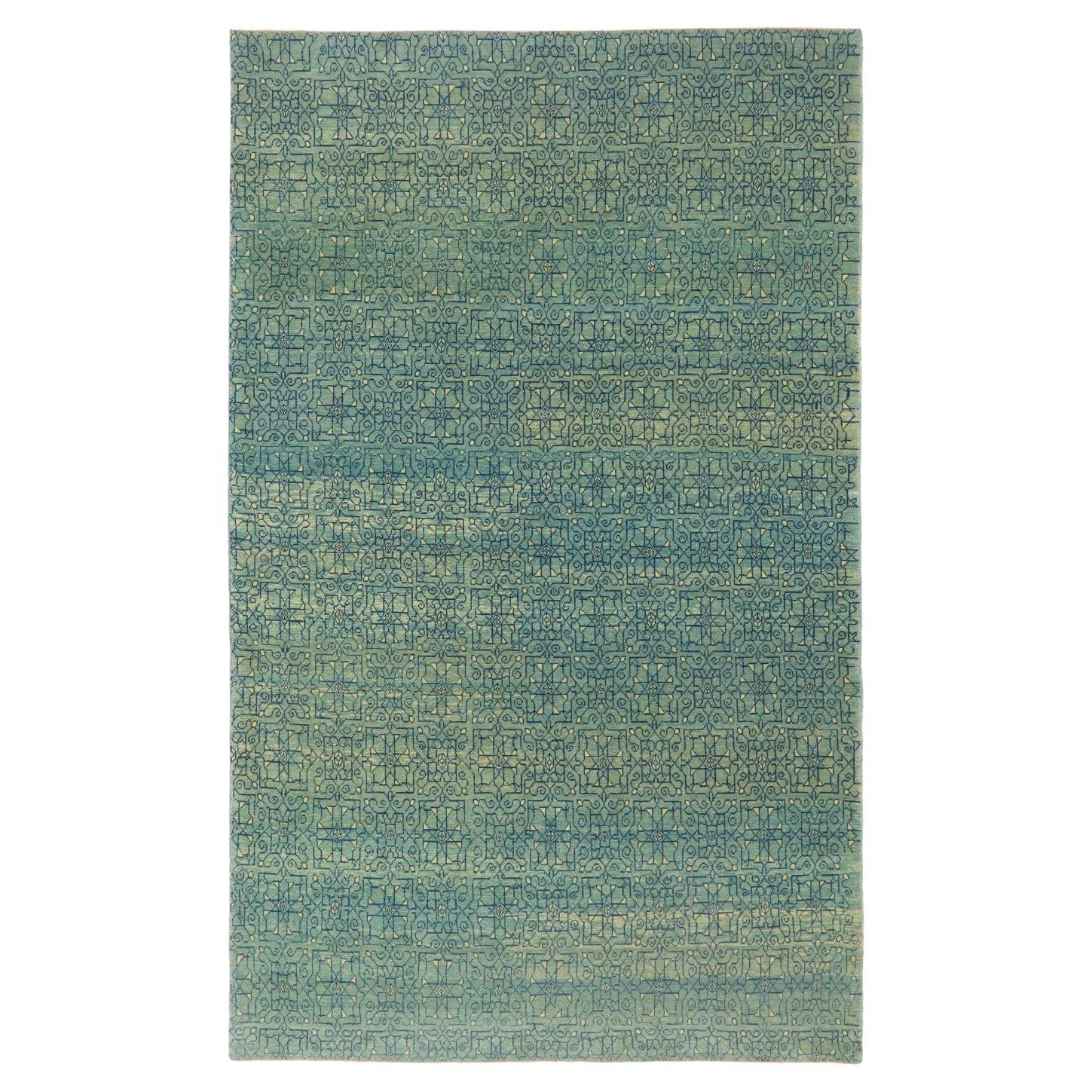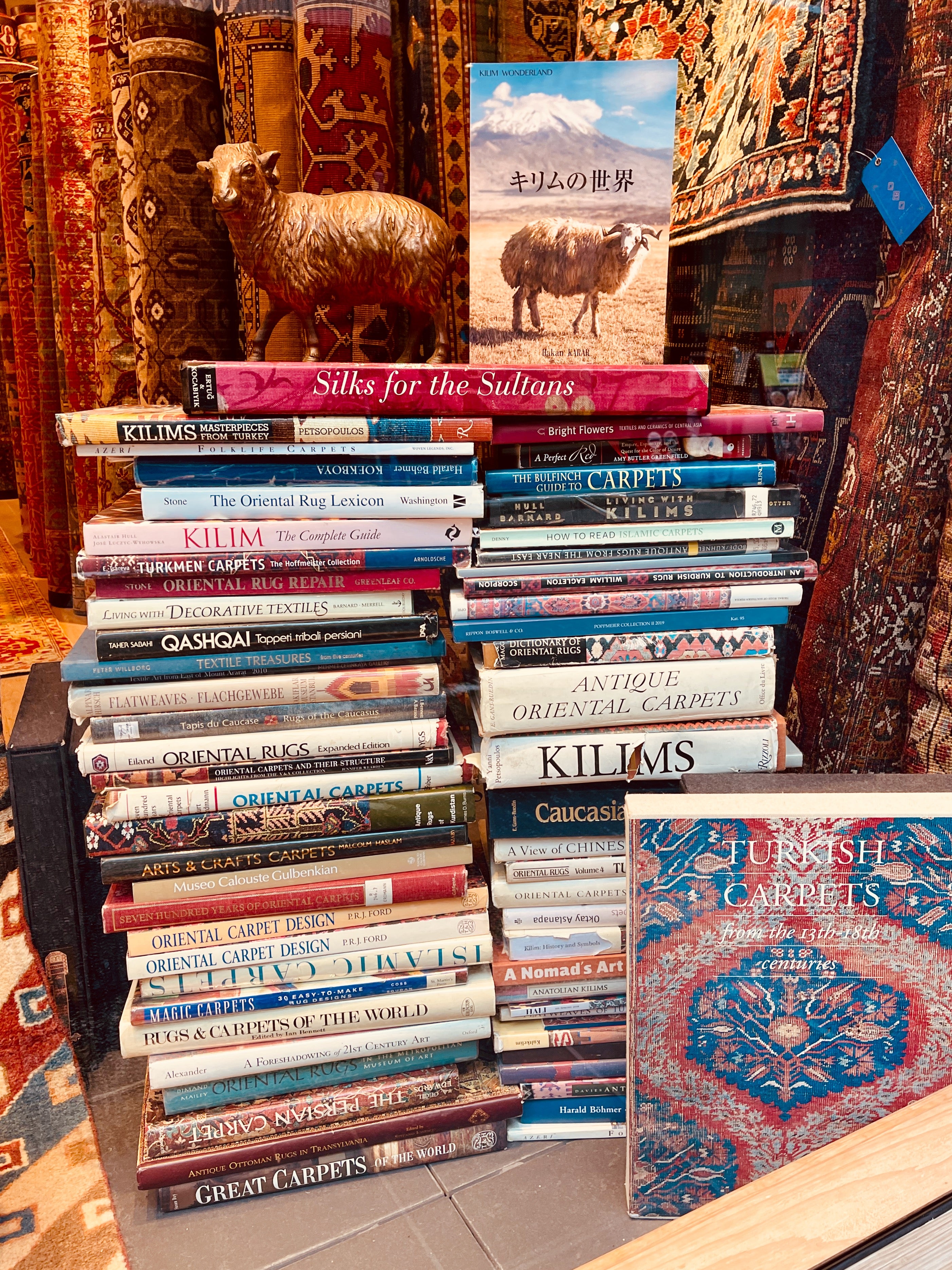Items Similar to Ararat Rugs Modern Rug with Mamluk Geometric Design, Natural Dyed Carpet
Video Loading
Want more images or videos?
Request additional images or videos from the seller
1 of 6
Ararat Rugs Modern Rug with Mamluk Geometric Design, Natural Dyed Carpet
About the Item
This rug has an interpreted design composed of a geometric lattice pattern taken from a part of the Mamluk rug, filling the field elegantly, has the impression that it is only part of a larger scheme designed 15th-century rug from the Mamluk era, Cairo region, Eygpt. Mamluk carpets originated in a physical environment that lacked the combination of abundant marginal grazing land and a temperate climate with cool winters that were common to most carpet-weaving areas in the Islamic world. While related to a broader tradition of Turkish weaving centered in Anatolia, far to the north, the designs of these carpets include atypical elements, such as stylized papyrus plants, that are deeply rooted in Egyptian tradition. Their unusual composition and layout probably represent an attempt to develop a distinctive product that could in effect establish a “Mamluk brand” in the lucrative European export market. The uncharacteristic color scheme—devoid of the undyed white pile and employing a limited range of three or five hues in much the same value—also suggests a conscious attempt to create a particular stylistic identity. Also virtually unique in the world of Islamic carpets is the S-spun wool. It has been argued that the tradition of clockwise wool spinning originated in Egypt because of the earlier Egyptian tradition of spinning flax into linen thread. Details of the plant’s botanical structure make it impossible to spin flax fiber in the more common counterclockwise direction utilized throughout the Middle East for wool and cotton.
Mamluk carpets with the color combinations seen in the Simonetti are now generally accepted as part of an earlier tradition that has many links to the weaving of Anatolia, Iran, and Syria. The “three-color” Mamluk carpets, well represented in the Metropolitan’s collection, represent a later development that continued well after the Ottoman conquest of Egypt in 1517. Many such carpets may have been produced well into the seventeenth century, and possibly even later. (Walter B. Denny in [Ekhtiar, Soucek, Canby, and Haidar 2011]). The design of the rug is interpreted by our designers from our Mamlouk-type rugs collection and soft colors are used for this rug.
Color summary: 2 colors of total
Bamboo Beige 99 (only specially washed)
Feldgrau 414 (Chamomile – indigo)
Group: Islamic Rugs Family
Area: Mamluk
Material of Pile: Natural Dyed Hand-spun Wool
Material Warp / Weft: Wool on Wool
Structure: Symmetrical knot on depressed warp inclining to the right
Knots Density: 39x39
Production Place: East Anatolia – Erzurum Province
Stock Location: Tokyo.
Size (EU): 224 X 157cm
Size (US): 7.4" X 5.1"
Area (EU): 3.5m²
Area (US): 37.9ft².
- Creator:Ararat Rugs (Manufacturer)
- Dimensions:Width: 61.82 in (157 cm)Length: 88.19 in (224 cm)
- Style:Revival (In the Style Of)
- Materials and Techniques:
- Place of Origin:
- Period:
- Date of Manufacture:2022
- Production Type:New & Custom(One of a Kind)
- Estimated Production Time:Available Now
- Condition:
- Seller Location:Tokyo, JP
- Reference Number:1stDibs: LU8206232799382
ARARAT RUGS
We know and believe that the geography we come from, our past, and our lifestyle are the most important bond between us to carry the oriental carpet art and culture to the next generations along with our core values in our ongoing growth journey.
We are aware that the way to achieve this goal and carry this priceless art and culture to the future depends on a lot of work with all our people every day while adhering to our core values.
For us, art is meaningful in the sense that it brings together various cultures around the world. It is an honor for us that oriental carpet art and culture have been instrumental in this for centuries and that we are a part of this business.
We are tirelessly keeping an eye on auction house information around the world about carpets. New York's Metropolitan, London's Victoria & Albert Museums, and other famous art museums, as well as small specialized museums that house private collections, and books about oriental carpets to collect information on outstanding carpet designs and patterns from around the world. It's our Self-improving and Self-developing culture.
As Turkish Culture of Hospitality, the Kurdish Culture of Generosity, and as Japanese Culture of Business Punctuality; are the most important values that this multicultural background has taught and bequeathed to us. It is essential and valuable for us that you feel this feeling not only by looking at our oriental carpets but from the moment you contact us.
About the Seller
5.0
Gold Seller
These expertly vetted sellers are highly rated and consistently exceed customer expectations.
Established in 1970
1stDibs seller since 2023
12 sales on 1stDibs
Typical response time: <1 hour
- ShippingRetrieving quote...Ships From: Tokyo, Japan
- Return PolicyA return for this item may be initiated within 7 days of delivery.
More From This SellerView All
- Ararat Rugs Modern Rug with Mamluk Geometric Design, Natural Dyed CarpetBy Ararat RugsLocated in Tokyo, JPThis rug has an interpreted design composed of a geometric lattice pattern taken from a part of the Mamluk rug, filling the field elegantly, has the impression that it is only part of a larger scheme designed 15th-century rug from the Mamluk era, Cairo region, Eygpt. Mamluk carpets originated in a physical environment that lacked the combination of abundant marginal grazing land and a temperate climate with cool winters that were common to most carpet-weaving areas in the Islamic world. While related to a broader tradition of Turkish weaving centered in Anatolia, far to the north, the designs of these carpets include atypical elements, such as stylized papyrus plants, that are deeply rooted in Egyptian tradition. Their unusual composition and layout probably represent an attempt to develop a distinctive product that could in effect establish a “Mamluk brand” in the lucrative European export market. The uncharacteristic color scheme—devoid of the undyed white pile and employing a limited range of three or five hues in much the same value—also suggests a conscious attempt to create a particular stylistic identity. Also virtually unique in the world of Islamic carpets is the S-spun wool. It has been argued that the tradition of clockwise wool spinning originated in Egypt because of the earlier Egyptian tradition of spinning flax into linen thread. Details of the plant’s botanical structure make it impossible to spin flax fiber in the more common counterclockwise direction utilized throughout the Middle East for wool and cotton. Mamluk carpets with the color combinations seen in the Simonetti are now generally accepted as part of an earlier tradition that has many links to the weaving of Anatolia, Iran, and Syria. The “three-color” Mamluk carpets, well represented in the Metropolitan’s collection, represent a later development that continued well after the Ottoman conquest of Egypt in 1517. Many such carpets may have been produced well into the seventeenth century, and possibly even later. (Walter B. Denny in [Ekhtiar, Soucek, Canby, and Haidar 2011]). The design of the rug is interpreted by our designers from our Mamlouk-type rugs collection and vivid colors are used for this rug. Color summary: 2 colors in total; Imperial Red 426 (Madder Root) Sunray Color 405 (Henna) Group: Islamic Rugs...Category
21st Century and Contemporary Turkish Revival Turkish Rugs
MaterialsNatural Fiber, Organic Material, Wool
- Ararat Rugs Mamluk Wagireh Rug with Geometric Design Revival Carpet Natural DyedBy Ararat RugsLocated in Tokyo, JPThis geometric lattice pattern rug has the impression that it is only part of a larger scheme designed 15th-century rug from the Mamluk era, Cairo region, Eygpt. These designs have o...Category
21st Century and Contemporary Turkish Revival Turkish Rugs
MaterialsNatural Fiber, Organic Material, Wool
- Ararat Rugs Mamluk Wagireh Rug with Geometric Design Revival Carpet Natural DyedBy Ararat RugsLocated in Tokyo, JPThis geometric lattice pattern rug has the impression that it is only part of a larger scheme-designed 15th-century rug from the Mamluk era, Cairo region, Eygpt. These designs have o...Category
21st Century and Contemporary Turkish Revival Turkish Rugs
MaterialsWool, Natural Fiber, Organic Material
- Ararat Rugs Modern Rug with Mamluk Jerrehian Border Design, Natural Dyed CarpetBy Ararat RugsLocated in Tokyo, JPThe source of rug comes from the possession of Endre Unger, which was sold at Sotheby’s in 1992. That rug with the central star was designed in the early 16th-century rug by Mamluk Sultane of Cairo, Egypt. The interpreted design is composed of Jerrehian rug’s border motifs lattice, covering the field elegantly. Mamluk carpets originated in a physical environment that lacked the combination of abundant marginal grazing land and a temperate climate with cool winters that were common to most carpet-weaving areas in the Islamic world. While related to a broader tradition of Turkish weaving centered in Anatolia, far to the north, the designs of these carpets include atypical elements, such as stylized papyrus plants, that are deeply rooted in Egyptian tradition. Their unusual composition and layout probably represent an attempt to develop a distinctive product that could in effect establish a “Mamluk brand” in the lucrative European export market. The uncharacteristic color scheme—devoid of the undyed white pile and employing a limited range of three or five hues in much the same value—also suggests a conscious attempt to create a particular stylistic identity. Also virtually unique in the world of Islamic carpets is the S-spun wool. It has been argued that the tradition of clockwise wool spinning originated in Egypt because of the earlier Egyptian tradition of spinning flax into linen thread. Details of the plant’s botanical structure make it impossible to spin flax fiber in the more common counterclockwise direction utilized throughout the Middle East for wool and cotton. Mamluk carpets with the color combinations seen in the Simonetti are now generally accepted as part of an earlier tradition that has many links to the weaving of Anatolia, Iran, and Syria. The “three-color” Mamluk carpets, well represented in the Metropolitan’s collection, represent a later development that continued well after the Ottoman conquest of Egypt in 1517. Many such carpets may have been produced well into the seventeenth century, and possibly even later. (Walter B. Denny in [Ekhtiar, Soucek, Canby, and Haidar 2011]). Our designers interpret the design of the rug from our Mamlouk-type rugs collection and soft colors are used for this rug. Color summary: 4 colors in total, the most used 3 colors are; Bamboo Beige 99 (Specially Washed) Natural Wool Color 37 (Specially Washed) Sunray Color 405 (Henna) Group: Islamic Rugs...Category
21st Century and Contemporary Turkish Revival Turkish Rugs
MaterialsWool, Natural Fiber, Organic Material
- Ararat Rugs Modern Rug with Mamluk Jerrehian Border Design, Natural Dyed CarpetBy Ararat RugsLocated in Tokyo, JPThe source rug comes from the possession of Endre Unger, which was sold at Sotheby’s in 1992. That rug with the central star was designed in the early 16th-century rug by Mamluk Sultane of Cairo, Egypt. The interpreted design is composed of Jerrehian rug’s border motifs lattice, covering the field elegantly. Mamluk carpets originated in a physical environment that lacked the combination of abundant marginal grazing land and a temperate climate with cool winters that were common to most carpet-weaving areas in the Islamic world. While related to a broader tradition of Turkish weaving centered in Anatolia, far to the north, the designs of these carpets include atypical elements, such as stylized papyrus plants, that are deeply rooted in Egyptian tradition. Their unusual composition and layout probably represent an attempt to develop a distinctive product that could in effect establish a “Mamluk brand” in the lucrative European export market. The uncharacteristic color scheme—devoid of the undyed white pile and employing a limited range of three or five hues in much the same value—also suggests a conscious attempt to create a particular stylistic identity. Also virtually unique in the world of Islamic carpets is the S-spun wool. It has been argued that the tradition of clockwise wool spinning originated in Egypt because of the earlier Egyptian tradition of spinning flax into linen thread. Details of the plant’s botanical structure make it impossible to spin flax fiber in the more common counterclockwise direction utilized throughout the Middle East for wool and cotton. Mamluk carpets with the color combinations seen in the Simonetti are now generally accepted as part of an earlier tradition that has many links to the weaving of Anatolia, Iran, and Syria. The “three-color” Mamluk carpets, well represented in the Metropolitan’s collection, represent a later development that continued well after the Ottoman conquest of Egypt in 1517. Many such carpets may have been produced well into the seventeenth century, and possibly even later. (Walter B. Denny in [Ekhtiar, Soucek, Canby, and Haidar 2011]). Our designers interpret the design of the rug from our Mamlouk-type rug designs and soft colors are used for this rug. Color summary: 3 colors in total ; Emerald green 407 (Chamomile – indigo) Gunmetal blue 409 (Indigo) Pale green 439 (Chamomile – Indigo) Group: Islamic Rugs...Category
21st Century and Contemporary Turkish Revival Turkish Rugs
MaterialsWool, Natural Fiber, Organic Material
- Ararat Rugs Modern Rug with Mamluk Jerrehian Border Design, Natural Dyed CarpetBy Ararat RugsLocated in Tokyo, JPThe source of the rug comes from the possession of Endre Unger, which was sold at Sotheby’s in 1992. That rug with the central star was designed in the early 16th-century rug by Maml...Category
21st Century and Contemporary Turkish Revival Turkish Rugs
MaterialsWool, Organic Material, Natural Fiber
You May Also Like
- Handmade Turkish Tulu Rug, 100% Natural Un-Dyed Wool, Modern Scandinavian CarpetLocated in Philadelphia, PA100% Natural Hand-Spun Wool of finest quality. These hand-knotted rugs are produced from scratch in our atelier located in Central Anatolia, famous for being one of the world's olde...Category
2010s Turkish Tulu Turkish Rugs
MaterialsWool
- Geometric Abstract Design Carpet / Rug, 1950sLocated in Praha, CZ- 1950s - Czechoslovakia - good original condition - cleanedCategory
Vintage 1950s Czech Mid-Century Modern Turkish Rugs
MaterialsGrasscloth
- Vintage Mamluk Rug with All-Over Ottoman DesignBy Keivan Woven ArtsLocated in Atlanta, GALarge Vintage Mamluk Rug, rug WL-266930, country of origin / type: Turkey / Mamluk, circa Late-20th Century. Measures: 8'11 x 11'9. Finely Handwoven i...Category
Late 20th Century Turkish Oushak Turkish Rugs
MaterialsWool
- Modern Moroccan Rug, 100% Natural Un-Dyed Wool, Custom Hand Knotted Tulu CarpetLocated in Philadelphia, PA100% Natural Hand-Spun Wool of finest quality. These hand-knotted rugs are produced from scratch in our atelier located in Central Anatolia, famous for being one of the world's olde...Category
21st Century and Contemporary Moroccan Modern Moroccan and North African...
MaterialsWool
- Vintage Over-Dyed Grey Rug Carpet Oriental Wool Area RugLocated in Hampshire, GBThis distressed over-dyed rug is one of the best choices as Home decor objects. This grey rug has been distressed and over-dyed to achieve a contemporary, worn piece. This unique pie...Category
Vintage 1950s Pakistani Revival Turkish Rugs
MaterialsWool, Cotton, Organic Material
- Handmade Turkish Vintage Rug Over-Dyed in Pink, Elegant Design CarpetLocated in Philadelphia, PAOur over-dyed rugs are all hand-knotted vintage pieces that are recreated in our workshop to cater to a wider range of interior design choices from modern to coastal, from industrial...Category
20th Century Turkish Modern Turkish Rugs
MaterialsWool, Cotton
Recently Viewed
View AllMore Ways To Browse
Rugs Modern In Stock
White Rug With Color
Lattice Rug
Large Designer Rugs
Large White Rug
Cool Rug
Cool Rugs
Lattice Design Rug
Natural Color Rug Large
Early 21st Century Living Room Rugs
Egypt Carpet
Rug Wool Egypt
White Large Area Rugs
White Beige Area Rugs
Metropolitan Carpet
Unusual Ottoman
White Washed Rug
White Wash Rug
